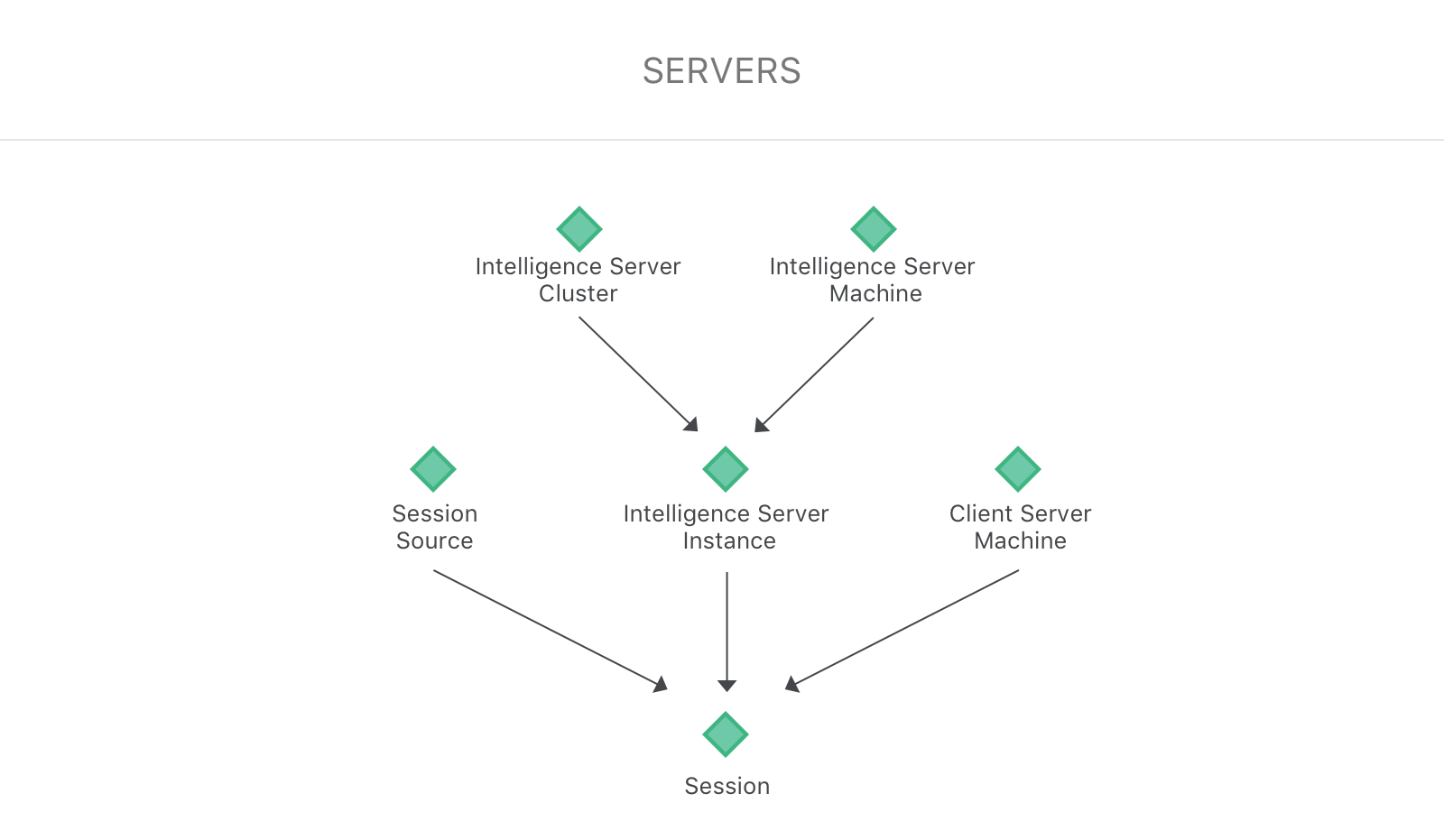Strategy ONE
Servers Hierarchy

The Server attributes allow for analysis at the machine level. The Intelligence server and Client Server Machine attributes provide the name and/or IP information for where an Intelligence server and Client Server are hosted.
Multiple server definitions can be available, but you can install only one Intelligence server on one Intelligence server machine and the Intelligence server uses only one Server Definition at a time.
lu_iserver_instance
List the Intelligence Server Instances that have been configured to monitor statistics using Platform Analytics. An Intelligence Server Instance uniquely identifies a MicroStrategy Intelligence server hosted on a machine. One Intelligence server uses only one server definition at a time.
|
Column |
Description |
Data-Type |
|---|---|---|
|
iserver_instance_id |
The auto-generated numeric ID for the Intelligence Server Instance. |
bigint(20) |
|
iserver_definition_guid |
The GUID of the server definition stored in the metadata. |
varchar(32) |
|
iserver_definition_name |
The name of the server definition stored in the metadata. |
varchar(255) |
|
iserver_machine_id |
The machine name where the Intelligence Server Instance is configured. |
bigint(20) |
|
iserver_port_number |
The port which the Intelligence Server Instance is configured. |
int(4) |
|
iserver_cluster_id |
The I-server Cluster ID. This is -1 by default. See the example of SQL for adding the cluster information below. |
smallint(4) |
| iserver_machine_name | The machine name where the Intelligence server is configured. | varchar(255) |
|
iserver_definition_id |
The auto-generated numeric ID of the Intelligence server definition. See lu_iserver_definition for more information. |
bigint(20) |
lu_iserver_machine
List the Intelligence server machines that have I-Servers configured to monitor statistics using Platform Analytics. An Intelligence server machine can have one or more instances of an Intelligence server running on different port numbers. An Intelligence server machine can have the IP, name, or both.
|
Column |
Description |
Data-Type |
|---|---|---|
|
iserver_machine_id |
The auto-generated numeric ID for the Intelligence server machine. |
bigint(20) |
|
iserver_machine_ip |
The machine IP where the Intelligence server is configured. |
varchar(32) |
|
iserver_machine_name |
The machine name where the Intelligence server is configured. |
varchar(255) |
lu_iserver_cluster
There is no automated method for determining the Intelligence server cluster information from the logs. However, this information can be manually updated. Examples of the procedure to update the lu_iserver_cluster and lu_iserver_instance tables are provided below. The Intelligence server cluster attribute is hidden by default.
If you want to cluster two Intelligence server instances (for example, iserver_instance_id = 1 and 2) together and name the cluster as "My MSTR Intelligence server cluster," then you can run the query below against the Platform Analytics WH.
Call add_iserver_cluster_for_instances('1,2', 'My MSTR Intelligence Server Cluster'); The procedure would give a result:
NEW ISERVER CLUSTER GENERATED:
ID = 1, NAME = My MSTR Intelligence Server Cluster |
Column |
Description |
Data-Type |
|---|---|---|
|
iserver_cluster_id |
The auto-generated numeric ID for the Intelligence server cluster. |
smallint(4) |
|
iserver_cluster_name |
The Intelligence server cluster name that was inserted through custom SQL. |
varchar(255) |
lu_client_server_machine
This table stores the Client Server Machine information where an application server, such as the Web Server or Mobile Server, is hosted.
|
Column |
Description |
Data-Type |
|---|---|---|
|
client_server_machine_id |
The auto-generated numeric ID for the Client Server Machine. |
bigint(20) |
|
client_server_machine_name |
Client machine name or IP address when machine name is not available. |
varchar(32) |
